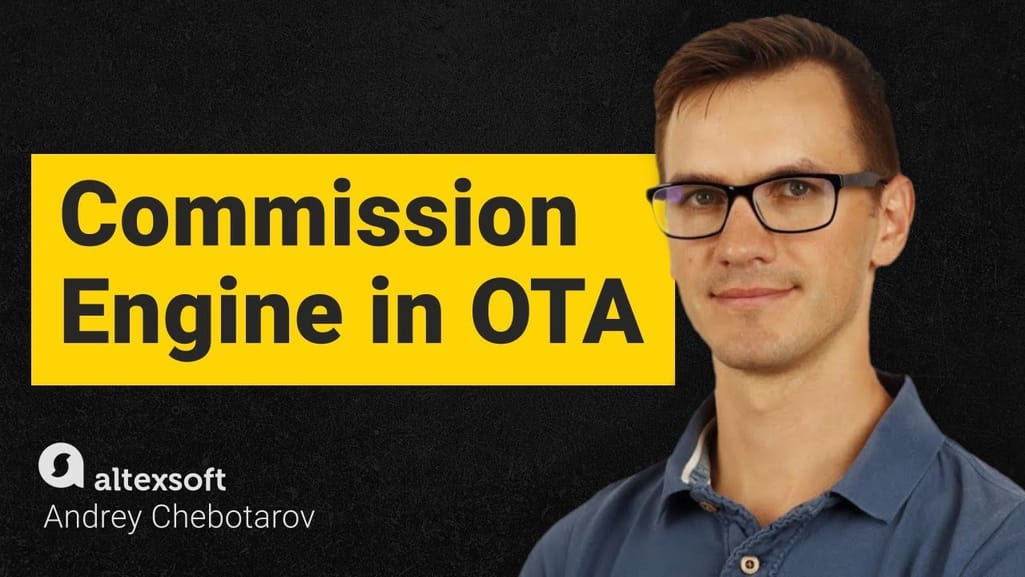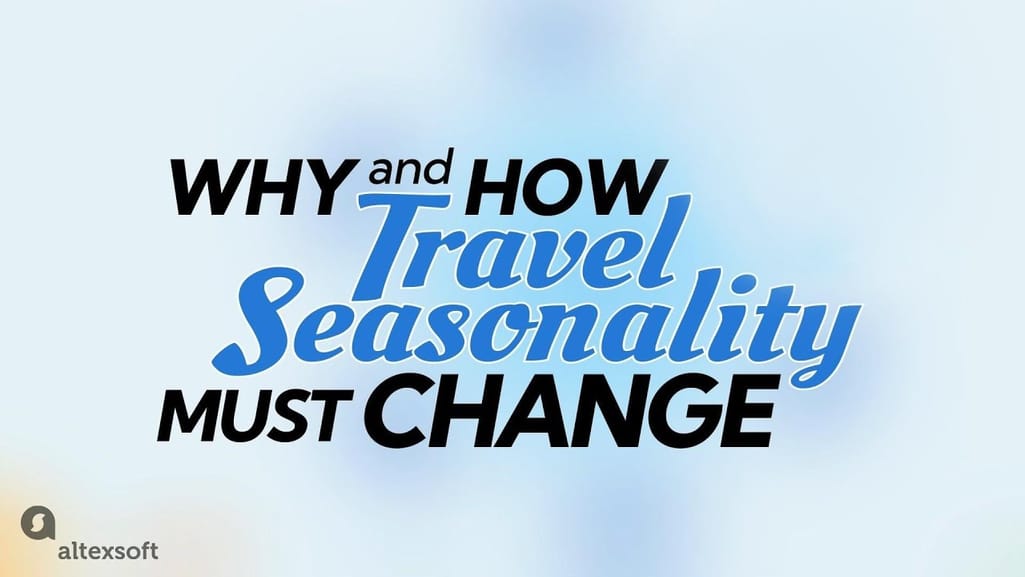Online travel agencies or OTAs earn most of their money on distribution services. They help hotels, airlines, car rental services, and other suppliers sell inventory to end customers — and charge fees for this mediation.
Though the business scheme is pretty straightforward, the same can’t be said for the financial calculations behind it. A big effort is required to set and finetune profitable prices. In this article, we’ll share our experience of building commission engines — a special type of travel agency software that helps revenue managers adjust fees and stay competitive under challenging market conditions.
OTA fees: how travel agencies collect them
There is no such thing as average or typical OTA fees. The commission rates vary largely across businesses and depend on many factors — for example, destination popularity or website traffic. Some OTAs invest up to 50 percent of their revenue in online marketing to increase visibility on the Internet — you can learn more about it from our video.


Understanding marketing in travel
The visibility offered by the leading players guarantees that travel providers will reach the widest customer base possible. Yet, this benefit comes with a price of high commissions.
Smaller OTAs can hold and grow their market share by setting lower commissions and overall being flexible with their pricing strategies. But before going any further, let’s briefly overview two standard models of relationships between travel suppliers and resellers.
How an agency model and merchant model differ
Commission contracted model
The first possible scenario is called a commission contracted or agency model. It unfolds as follows:
- A supplier (for example, an airline or hotel) sets the final prices (gross rates) and passes them to an OTA.
- The payment for a reservation made via OTA goes directly to the supplier — either at the time of booking or check-in.
- The supplier pays the OTA a commission after the guest checks out or reaches the destination.
Fees depend on the market share and exposure of the OTA, hotel size, and location. Major players like Expedia set rates as high as 25-30 percent for small hotels and 10-15 percent for big brands.
After commissions are agreed upon, all that’s left to do for OTAs is track booking volumes and send invoices for their services. Suppliers are the ones who keep control of final rates which allows them to be flexible with their pricing strategies.
Net contracted model
The following approach is a net contracted or merchant model.
- A supplier gives an OTA its products at a negotiated net rate.
- The OTA forms final prices by adding markups.
- The payment for the booking goes to the OTA, which in turn passes the net price to the supplier — typically, at the moment of payment or after check-in.
OTAs typically mix and match the two approaches. For example, Expedia mostly operates under the merchant model while its main rival, Booking.com, succeeded, using the agency model which promises many advantages to hotels. But in recent years, Booking.com increased the number of net-contracted bookings. In 2022, their share hit 40 percent which is twice as much as in 2018.
Booking.com is gradually shifting from an agency to a merchant model. Source: Mirai
The key reason for this shift is that the merchant model allows distributors to keep control of their pricing strategies. They can add markups, offer discounts, introduce new payment methods, and run loyalty programs at their own discretion, independently from suppliers.
That’s why the net contracted scenario remains the standard among OTAs and bed banks. But to make the most of it, agencies require special software for adjusting rates and automating complex pricing operations. Many travel businesses relying on the merchant model became our clients for whom we designed tailored commission engines.
What is an OTA commission engine?
An OTA commission engine is a software module that automatically calculates markups and markdowns to get the total cost of the travel product, be it a hotel room, a flight ticket, a package tour, or a car rental. That’s the price an end user pays when making a reservation on the travel website.


How commissions and a commission engine work in the OTA
Though called the commission engine, the tool processes all price components OTAs leverage. This includes
- OTA commissions or markups,
- services and payment fees, and
- discounts and coupons.
Let’s discuss each of them in more detail.
Components of prices a commission engine works with
OTA commission rate: invisible fees for distribution services
As we said before, OTAs commonly earn money by adding special fees, also called commission rates or markups on top of hotel prices. This extra payment remains invisible to an end user or traveler who sees only the total cost of the reservation.
Flat fee vs variable rates
The logic behind the calculation of commissions in the net contracted model varies from OTA to OTA and depends on the business size, revenue strategy, and the number of parameters considered. AltexSoft worked on numerous types of markups, yet all of them fall into two large groups:
- flat rates when you add the same amount of money (say, $10) or a fixed percentage of the net price to each booking, no matter the product characteristics; and
- variable rates allowing you to adjust markups depending on multiple factors.
The first type suits startups that aim at going live as soon as possible. They need to earn money on transactions but don’t have time to build complex revenue strategies.
“One of our clients, an alternative accommodation provider, wanted their vacation rental software to be launched in two months. To shorten time to market, developers inserted a flat rate logic directly into the code. There was no UI to control pricing: The system just automatically added a certain amount of money on top of each reservation,” Yuliia Mozharova, a Digital Solution Designer for Travel and Transportation at AltexSoft, recalls.
In the long run, if you want your online travel agency to grow, such a simple and straightforward solution won’t work effectively. “You can’t be flexible with your prices. And if you’re not flexible you can’t win the competition”, Andrii Chebotarov, a Travel Technology Competence Leader at AltexSoft reveals about the problem.
Later, we elaborated on a more complex commission tool for the above-mentioned client. The new software enables revenue managers to control markups in the OTA’s back-office system and adjust them taking into account multiple parameters.
Parameters dictating commission rates
Revenue managers working in the travel business consider a range of parameters to set an optimal price — the highest possible one which still remains competitive. Below, we’ll specify some of them.
Location. The overall popularity of the destination along with the distance from the city center and top attractions are key determinants of the accommodation price. A markup for a hotel in the downtown area of a heavily visited city may hit 20 percent and more. At the same time, a 5 percent fee can be enough for non-touristy places.
Seasonality. It inevitably affects tourism volumes and consequently — flight demand, hotel occupancy rates, and other aspects of the travel business. Watch our video to learn more.


Seasonal travel explained
Product type. OTA fees for hotel bookings range from 5 to 30 percent. Air travel markups are in most cases almost non-existent, with the exception of private fares sourced from airline consolidators. Rates applicable to other types of products — tours, car rentals, cruises — amount to 10-17 percent.
Booking channel. Some OTAs set different commissions on bookings coming from the direct channel (the travel agency’s website) and metasearch platform.
Type of device. Companies who want to boost bookings via smartphone offer prices with lower markups if a traveler makes reservations with a mobile app rather than on a website.
Customer type. If a travel agency supports several business models, it can diversify markups accordingly. One of our clients, a big Middle East OTA, wanted a commission engine to charge different fees depending on the customer type — namely
- end users (business-to-customer or B2C model),
- travel businesses like corporate travel management companies (business-to-business or B2B model), and
- governmental bodies (business-to-government or B2G model).
Revenue managers use many other parameters when defining markups. This includes check-in and check-out dates, flight origin and destination cities, the booking window (the time between the reservation being made and arrival at the property), and many more. A particular hotel chain or airline may also matter.
Service and payment fees
Service and payment fees are components of the price OTAs display to travelers. For example, when you buy an air ticket for $1,000, the system may charge you an extra 2 percent for taking care of your reservation. You’ll be informed about it somewhere at the end of the flight booking process. As a result, the final price will hit $1,020.
Payment fees apply to each online transaction processed by payment gateways and other service providers. PayPal’s standard rate for US domestic transactions is 3.49 percent plus 49 cents while Stripe and Square take 2.9 percent plus 30 cents per card charge. Some OTAs charge travelers for payment processing during the reservation, displaying transaction fees of different providers on the website. Others cover these costs by increasing markups.
Discounts and coupons
Coupons and discounts are enduring promotion tools that never fail to attract customers and increase booking numbers. Discounts can be represented as a strikethrough price next to the negotiated rate or in the form of a percentage. Many OTAs use both methods to draw attention to the bargain.
Expedia uses both percentage and strikethrough visualizing methods for discounts.
Coupons play a similar role as discounts but they require extra steps to be performed behind the scenes. “A system needs to validate whether a user has entered the right code. Also, the coupon may expire or be already utilized,” Yuliia Mozharova says. “All these and other possibilities entail extra logic to be baked into the code.”
Now, it’s time to see how the software in question actually works and what challenges OTAs can face when building it.
How a commission engine works and what to consider when designing it
From the commission engine perspective, there is no difference between visible and invisible fees or markups and discounts. All of them are just a set of rules and parameters the system uses to calculate the final price. The number of those rules varies from just a couple to dozens depending on your company's size and other specifics.
“When you only start your OTA, it typically doesn’t need complex logic. Your priority is to go online and begin to sell products as soon as possible.” Yuliia Mozharova suggests. “In this case, a simple solution with a couple of parameters considered — say, product type and location — will do and ensure a fast time to market. Then you can gradually build up functionality."
Business growth inevitably entails introducing new parameters and developing more sophisticated rules that will allow you to stay competitive. On the dark side, each new condition adds complexity to the system and brings new challenges. Below, we’ll disclose some best practices to handle the most common problems.
Set rule priorities
When the system takes into account a large number of parameters, it inevitably results in rule conflicts. For instance, one rule requires adding a 15-percent markup for hotels in France while another dictates a 20-percent commission for hotels in Paris. Which of the two should be applied?
To help the commission engine out, you need to set clear priorities when designing the software. Usually, a rule with a narrower focus has greater weight. In our example, Paris wins the argument, so a traveler will be charged 20 percent on top of the net booking price.
You also have to decide which parameters matter more: supplier, location, booking dates, product type, and so on. To give you a better understanding, we’ll describe a real-life rule conflict our team faced when working on a commission engine.
The example of possible rule conflicts
Our client, a B2B travel platform specializing in condo rentals, used two parameters to define markups — a type of supplier (a vacation rental company, or VRC and all others) and a type of customer (a host agency and all others.)
As the rule matrix above shows, vacation rental companies and customers other than host agencies trigger Rule 1 and a 15-percent markup. In turn, all other suppliers and host agencies fall under Rule 2. But what if a host agency books a condo provided by a VRC? To resolve the conflict, the client agreed on giving a higher priority to the parameter Customer. So, host agencies will pay a 25-percent commission, no matter the supplier.
Focus on quality assurance
The conflict we described above is quite simple since it involves only two variables. Often, you have to deal with numerous parameters, entailing deviations and mistakes that are sometimes not as obvious.
Designing and implementing rules is only a part of the job, and not necessarily the most lengthy one. Quality assurance and testing may take more time, playing a crucial role in the efficiency of the commission engine.
QA engineers should disclose hidden conflicts and check how and when each rule works. “Say a supplier’s price is $200 and the website shows us $230. Before going live, there must be a clear understanding of exactly which rule was applied,” Yuliia Mozharova warns.
Create a default rule
However experienced your developers and QA engineers are, there is always a possibility that after covering numerous scenarios a certain case will still remain hidden. If the system has no rule to follow, it will add no markup and the booking will be sold at the net price. Good news for the travelers but not for the mediators who will earn nothing for their efforts.
To prevent money losses, our recommendation is to implement a default rule which comes into play if no other instructions fit the situation. The default rule works for all bookings regardless of their parameters. Typically, it applies an industry average markup.
Take a closer look at the Travel Now Pay Later trend
Travel Now Pay Later and Fly Now Pay Later are versions of the Buy Now Pay Later (BNPL) structure. In a nutshell, it’s a cheap and accessible type of short-term online credit when the total cost of the trip or vacation is divided into a sequence of payments. Often, no interest is charged if a traveler makes timely payment of the debt.
Recent research by Amadeus, one of the world’s leading global distribution systems, shows that almost 70 percent of travelers are ready to spend more on flights and hotels in case the BNPL service is available. No surprise, many OTAs started offering this payment option to their clients.
How does it relate to the commission engine? In the same way as any other factors that impact the final price we mentioned above. If you want your OTA to take advantage of the BNPL, you need to implement rules that would split markups accordingly.
Don’t underestimate the importance of the user interface
Though the software automates a lot of pricing operations, it’s still up to humans — namely, revenue managers — to add, configure, and cancel rules and update markups. OTAs have to constantly adapt to the changing market. The user-friendly and intuitive interface of the commission engine will make the daily routine of the people in charge of those adjustments much easier.
Business intelligence and machine learning: advanced approaches to pricing
A regular commission engine assigns markups and markdowns to base prices, following the predefined business logic. The tool neither creates new rules nor changes rates at its own discretion. It’s revenue managers who do market research, check competitor prices, and track performance metrics on a daily or weekly basis to set markups that will attract customers but still earn money.
Today, revenue managers can use business intelligence tools to understand how well the current rates work. Another popular option is to reach out to an analytics company for getting recommended prices and adjust markups accordingly.
One of our clients provides such recommendations based on a customer’s historical data and competitive analysis. The AltexSoft team is currently working on a machine learning module that will enable their analytics platform to consider more factors impacting prices and process data faster.
The above-mentioned shift to an ML-driven solution is not unique or rare — it’s becoming a trend in travel technologies and particularly in pricing. You can read about our experience with
- creating an ML-driven flight price predictor,
- training a price elasticity model to set early booking rates, and
- building an algorithm for occupancy rate prediction that is more than helpful in a price adjustment.
When it comes to commission engines for OTAs, ML has a lot to offer as well. Online travel agencies per se accumulate enough data to power advanced machine learning models with a range of capabilities.
“You may forecast when demand will rise or fall and adjust your rules to benefit from these changes,” says Andrii Chebotarov, referring to possible applications. “Or you can predict optimal commission sizes and even automate some operations.” While final decisions are still made by human professionals, ML can help them find the best solutions in less time.
